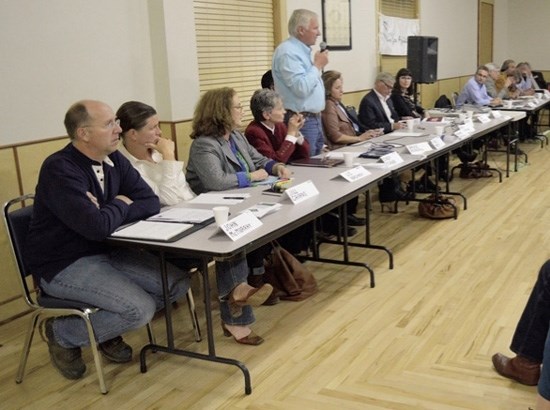Rocky View County (RVC) election candidates were in the hot seat Oct. 2 as they informed residents where they stand on heated county issues such as debt, emergency services, affects of development, agriculture and seniors services.
Sixteen of the 20 candidates running were present at the forum hosted by Action for Agriculture at the Golden Rod Hall from 6:30 p.m. to 9 p.m. All Division 5 candidates – Earl Solberg, Bob Gaidhar and Jerry Gautreau - were absent, as well as Division 6 incumbent Greg Boehlke.
Candidates were given five minutes to introduce themselves and answer several questions provided by Action for Agriculture.
A question from a Springbank resident asked candidates about their stance on the county’s current $66 million in debt rooted in building water and wastewater infrastructure in East Balzac sparked debate among candidates.
Ten-year Balzac councillor Lois Habberfield said the council-of-the-day’s decision to diversify the county’s tax base with commercial and industrial development has been “a success story.”
“It’s ridiculous to say this has been a failure. The economic development in East Balzac is not a folly. It is generating more and more taxes every year, more and more levies are coming in,” she added.
“The debt is there, it’s being controlled, it’s being paid, it’s accomplished what it’s intended to accomplish and I can hardly wait for the day it’s paid down,” said Division 4 councillor and reeve Rolly Ashdown.
Ashdown’s opponent, Gerard Lucyshyn disagreed.
“Debt was taken on as a huge gamble... we gambled wrong and now we have this huge debt we have to pay down. Having the taxpayers pay down the debt is totally unacceptable. We need to use this tax diversification strategy to pay it off,” he said.
Candidates unanimously agreed on an answer to a question asked by Action for Agriculture about the importance of agriculture in RVC.
“I think we’d be foolish to admit that agriculture isn’t the dominant force in RVC. Currently it’s about 92 per cent (of the land base) and out of (the county’s) million acres, that’s a lot of acres. Across Canada it’s a huge economic generator. The only problem we have with agriculture is it only contributes about two per cent of the tax base to RVC,” said Division 9 candidate Bruce Kendall.
Current councillors Lois Habberfield and Al Sacuta both said agriculture is important and should be preserved, but some land isn’t suitable for agriculture production and should be considered for proper kinds of development.
Leading the debate about RVS’s future landscape, candidates were asked about their stance on the recently approved County Plan and it’s growth target of 2.5 to three per cent of the region’s growth over the next decade.
Several candidates, including Margaret Bahcheli, Ashdown and Liz Breakey said they are supportive of the County Plan and that the market would dictate growth.
“It’s a regional growth number. It (the 2.5 to three per cent figure) reads badly as though we’ve capped growth: absolutely not. What it does is it links to the economy and makes it very market-facing and very demand focus. If Calgary booms, then RVC booms. If the demand’s up, we’re there for you and if the demand’s down, we’re going to plan for that,” said Bahcheli.
Division 6 candidate John McMurray said 2.5 to three percent should be a growth limit and not a goal.
“We shouldn’t try to be encouraging more growth if it doesn’t meet that. We know residential development is a money-losing business because it costs more to provide services than it brings in,” he said.
Norman Kent, one of the three candidates running in Division 9 said growth is inevitable in RVC.
A final question asked by Action for Agriculture was if candidates thought developers should be required to show proof they have water for a development before receiving approval for land use from council.
“Not only should they prove (they have) water, but also the quantity and quality should be proved. Water is blue gold,” said Cameron Wallace.
Several candidates said it depended on the type of application.
“Obviously if it’s a small first parcel-out or a farmer trying to re-subdivide his land, there’s a less-need to have a detailed engineering report of water supply,” said Sacuta.




